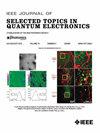受激拉曼散射显微镜光纤放大器的优化设计
IF 5.1
2区 工程技术
Q1 ENGINEERING, ELECTRICAL & ELECTRONIC
IEEE Journal of Selected Topics in Quantum Electronics
Pub Date : 2025-10-01
DOI:10.1109/JSTQE.2025.3616654
引用次数: 0
摘要
光谱聚焦是利用啁啾飞秒激光器获取高光谱相干拉曼图像的一种快速、可靠、简单的方法。先前的工作已经证明了使用抛物线光纤放大器进行斯托克斯脉冲放大,这增加了受激拉曼散射(SRS)显微镜中斯托克斯脉冲的带宽,从而扩大了光谱范围。然而,确定光纤放大器设计的最佳参数-如光纤长度,输入泵浦功率和输入斯托克斯脉冲被放大的峰值功率-尚未深入探讨该应用。在这项研究中,我们进行了数值模拟,以找到理想的光纤放大器参数,以解决这一限制。利用光纤段长度构建Stokes脉冲光纤放大器(SPFA),为放大后的Stokes脉冲提供高功率谱密度、频谱带宽、啁啾率和啁啾线性度的最佳组合,并对结果进行了实证验证。我们展示了具有集成SPFA的SRS显微镜的高质量性能,用于成像生物样品,其光谱范围从典型的200 cm−1增加到400 cm−1,而没有这种放大。这项工作为那些希望建立类似系统的人提供了有价值的见解和详细的分析,提供了在以前的文献中没有彻底解决的重要信息。本文章由计算机程序翻译,如有差异,请以英文原文为准。
Optimization of Fiber Amplifier Design for Stimulated Raman Scattering Microscopy
Spectral focusing is a rapid, reliable, and simple method for acquiring hyperspectral coherent Raman images using chirped femtosecond lasers. Previous work has demonstrated the use of a parabolic fiber amplifier for Stokes pulse amplification, which increases the bandwidth of Stokes pulses in stimulated Raman scattering (SRS) microscopy with spectral focusing, thereby expanding the spectral range. However, determining the optimal parameters of the fiber amplifier design — such as fiber lengths, input pump power, and peak power of the input Stokes pulse being amplified — has not been explored in depth for this application. In this study, we performed numerical simulations to find the ideal fiber amplifier parameters to address this limitation. We constructed a Stokes pulse fiber amplifier (SPFA) using fiber section lengths that produced the optimal combination of high-power spectral density, spectral bandwidth, chirp rate, and chirp linearity for the amplified Stokes pulse, and verified the results empirically. We demonstrate the high-quality performance of the SRS microscope with the integrated SPFA for imaging biological samples with a spectral range increased to 400 cm−1 from the typical 200 cm−1 without such amplification. This work provides valuable insights and detailed analysis for those looking to build similar systems, offering important information that has not been thoroughly addressed in previous literature.
求助全文
通过发布文献求助,成功后即可免费获取论文全文。
去求助
来源期刊

IEEE Journal of Selected Topics in Quantum Electronics
工程技术-工程:电子与电气
CiteScore
10.60
自引率
2.00%
发文量
212
审稿时长
3 months
期刊介绍:
Papers published in the IEEE Journal of Selected Topics in Quantum Electronics fall within the broad field of science and technology of quantum electronics of a device, subsystem, or system-oriented nature. Each issue is devoted to a specific topic within this broad spectrum. Announcements of the topical areas planned for future issues, along with deadlines for receipt of manuscripts, are published in this Journal and in the IEEE Journal of Quantum Electronics. Generally, the scope of manuscripts appropriate to this Journal is the same as that for the IEEE Journal of Quantum Electronics. Manuscripts are published that report original theoretical and/or experimental research results that advance the scientific and technological base of quantum electronics devices, systems, or applications. The Journal is dedicated toward publishing research results that advance the state of the art or add to the understanding of the generation, amplification, modulation, detection, waveguiding, or propagation characteristics of coherent electromagnetic radiation having sub-millimeter and shorter wavelengths. In order to be suitable for publication in this Journal, the content of manuscripts concerned with subject-related research must have a potential impact on advancing the technological base of quantum electronic devices, systems, and/or applications. Potential authors of subject-related research have the responsibility of pointing out this potential impact. System-oriented manuscripts must be concerned with systems that perform a function previously unavailable or that outperform previously established systems that did not use quantum electronic components or concepts. Tutorial and review papers are by invitation only.
 求助内容:
求助内容: 应助结果提醒方式:
应助结果提醒方式:


